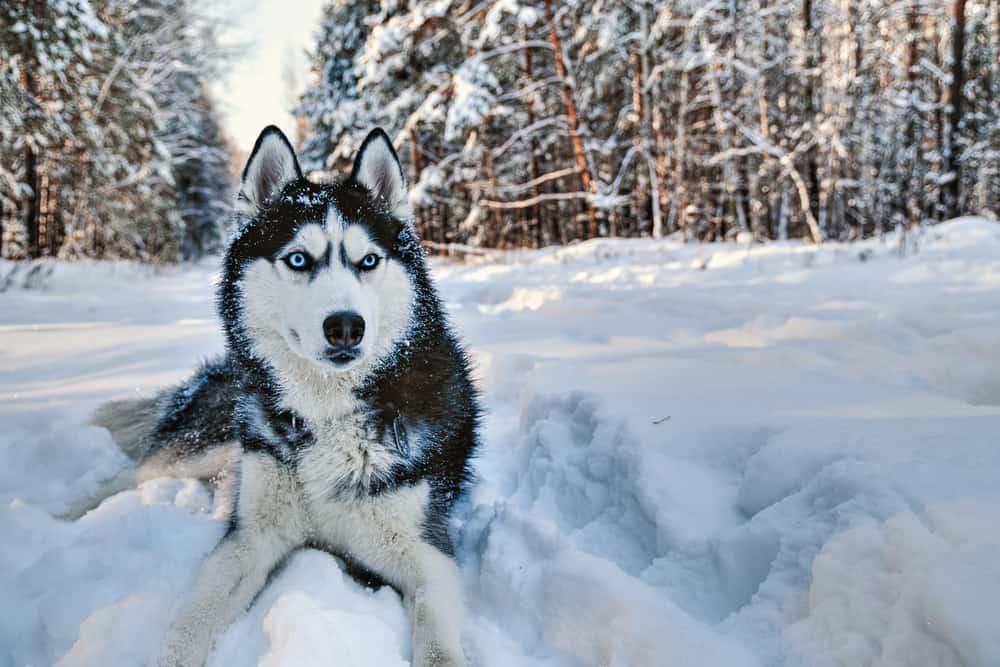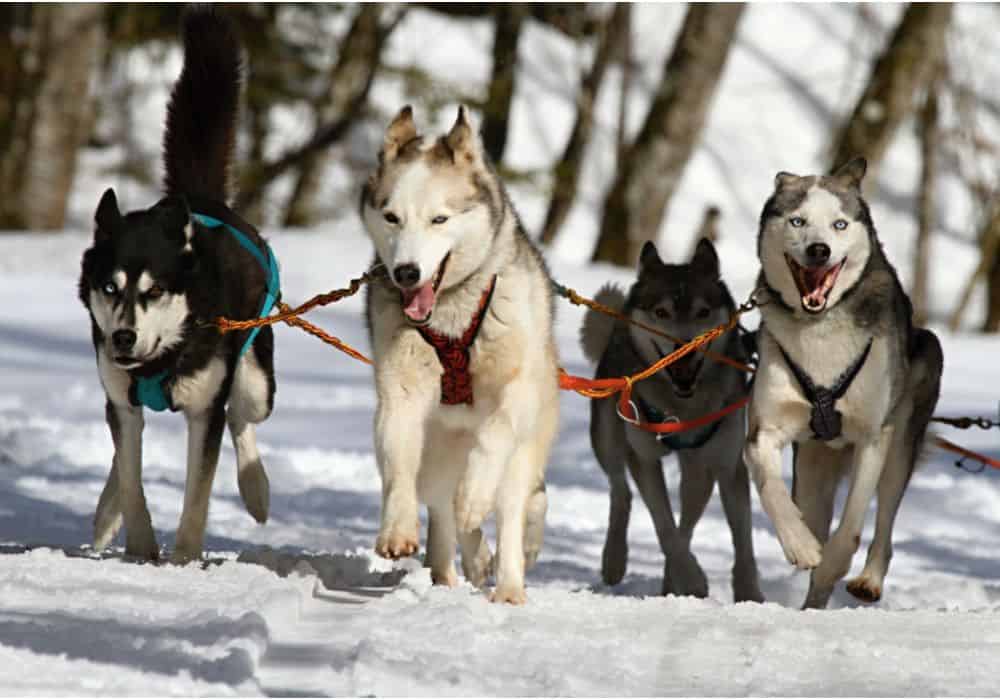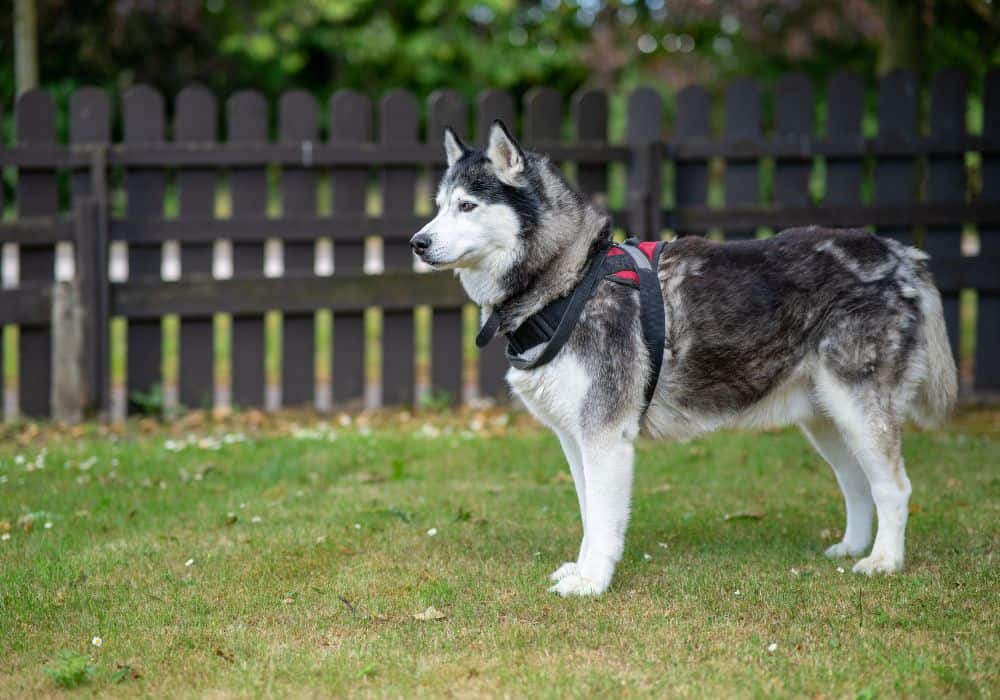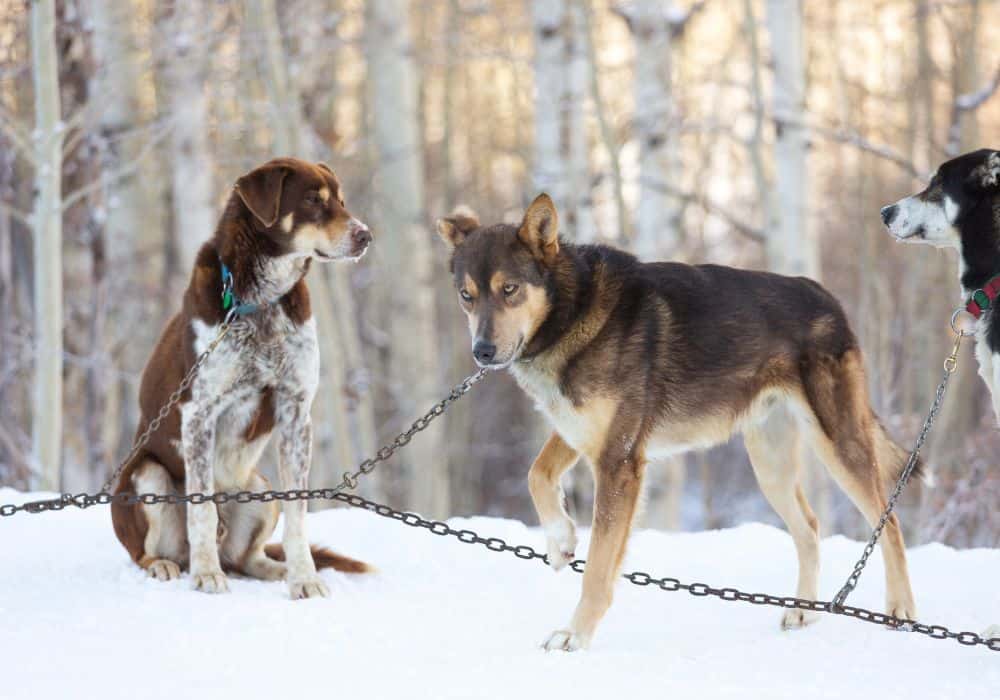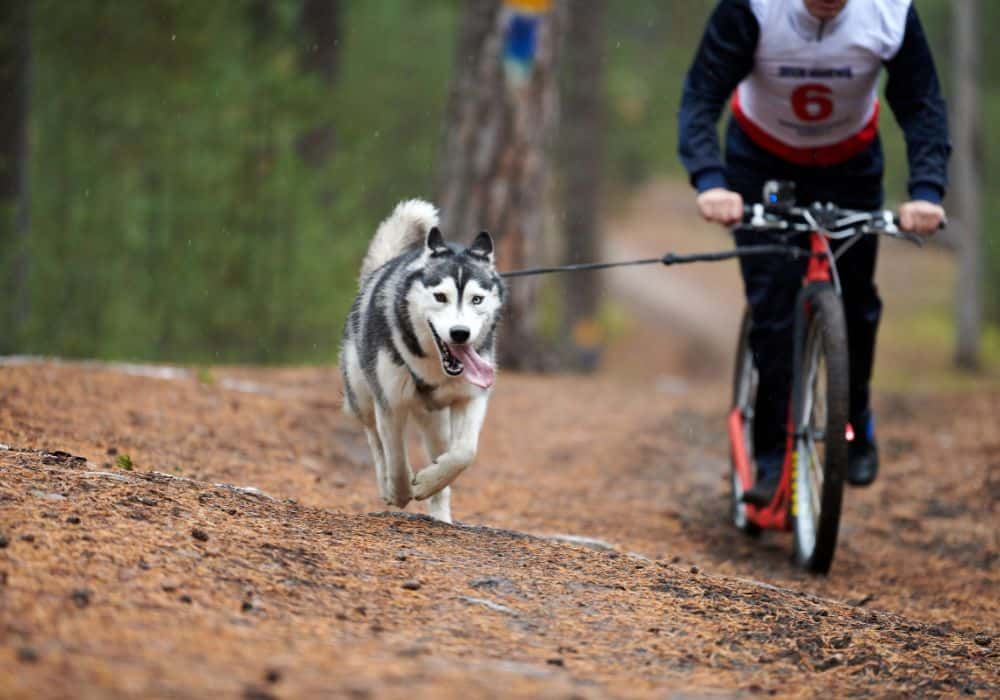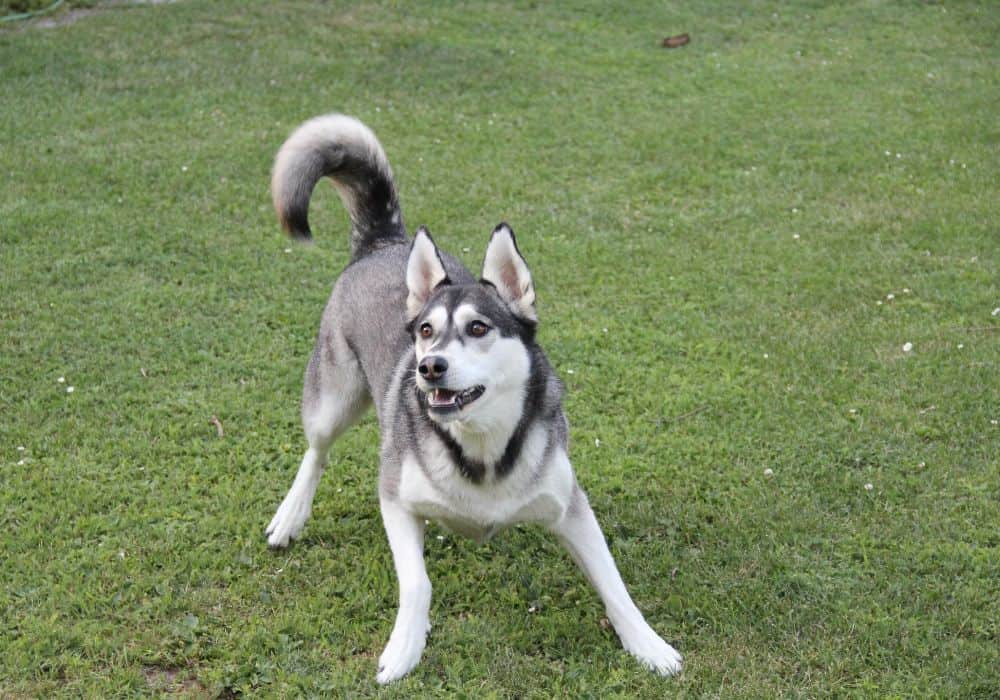As specially-bred and ancient sled dogs used to life in the Alaskan and Siberian wilds, huskies require a good deal more specialist care than other, smaller dog breeds. They need to get the right amount of stimulation, benefit best in packs, and require a carefully-curated diet.
In this article, we’ll walk you through an introduction to huskies as a pet dog breed – what huskies should be fed (and like to eat), as well as how much and how often they need to eat, what you should avoid feeding them, and finally some top tips on caring for your pet husky.
An Introduction to Huskies
History of the Husky
The term ‘husky’ is a rather general and unspecific term for any working dog found (and originally bred) in the world’s polar regions. In fact, many of the dogs today known as huskies were not originally ‘huskies’ at all, but other dog breeds mistaken for the classic Alaskan husky by people who simply didn’t know better.
The word itself is a bastardisation of references made to the pre-Columbian indigenous populations of the Canadian and Alaskan high-arctic, once known as the Eskimo peoples (the Inuit and Yupik). When the word ‘husky’ first began to circulate in the mid-late 18th century, ‘Eskimo’ was pronounced in varying ways: ‘Uskee’, ‘Uskimay’ and ‘Huskemaw’.
The dogs which these indigenous groups used were, therefore, known as Uskee/Huskemaw dogs, which in turn, over time, became ‘husky dogs’.
Huskies have been working dogs for their entire existence, used by indigenous Arctic and Siberian peoples to pull their sleds for transportation and on hunting expeditions. Today, they continue to be used for this purpose, but are now also used in sled racing, tourism, and found as pets in homes all around the world – even in climates far removed from their cold home!
Appearance of the Husky
Huskies are gorgeous dogs, very closely resembling wolves in appearance and sharing a closer genetic relationship to their wild ancestors than many other dog breeds. Since the term ‘husky’ can refer to a number of different breeds, there is no set of characteristics which may define all huskies.
Having said that, huskies generally have thick double coats of gray, black, brown, and/or caramel with white bellies. They have pointed triangular ears, long muzzles, tall legs and lean, muscular bodies. Their eyes are often a piercing blue, but they can also be heterochromic (with two different colored irises) or brown, green, or yellow.
Husky Breeds
There are a number of different ‘breeds’ known as huskies, even though many true huskies are mutts, bred from any dog and any breed which exhibits traits useful to Inuit or Canadian/Alaskan breeders, racers, and tourist companies.
The most recognisable husky breeds include the following:
- Siberian Huskies
These huskies are actually descendants of the Siberian Chukchi people’s Chukotka sled dogs, which had been around since perhaps 2,000BCE (or 4,000 years ago!). These dogs were introduced to Alaska in the early 1900s and subsequently mistaken for huskies, which is why they continue to be known as such to this day!
- Alaskan Huskies
Alaskan huskies are mongrels bred for their speed and endurance, specifically for use in dog sled racing. Over the past 100 years, they’ve been interbred with a wide range of dogs from a variety of breeds including: English Pointers, German Shepherds, and Salukis. As such, individual Alaskan huskies don’t resemble other husky breeds, nor often even each other.
- Sakhalin Huskies
On the cold, barren, northern isles situated north of Japan live the descendants of the indigenous Nivkh people. They, like most of the First Nations peoples living in and around the Arctic circle, also bred working dogs. Sakhalin huskies (also known as Karafuto Ken in Japanese), however, are unfortunately today on the cusp of extinction. As of 2011, only two purebred members of the breed survived, and their breeder died in 2012.
- Labrador Huskies
Completely unrelated to Labradors, Labrador huskies probably came to North America with their Inuit breeders around 700 years ago, landing in the Canadian provinces of Newfoundland and Labrador. Today, there are perhaps only 50-60 Labrador huskies left alive in the whole world.
Husky Behavior and Traits
Huskies are work dogs, and as such have a high abundance of energy which they must exert on a regular basis either through work, play, or walks. They can become easily restless, and are prone to tearing up furniture, carpets, and back gardens if under-stimulated by their owners.
They also require a specialist diet and can be more prone to uveitis than other dog breeds. As such, it’s important that you think long and hard about your ability to provide the right kind of care before investing in husky puppies.
Having said that, huskies also make for really fantastic life-companions. They are generally friendly and approachable, even with strangers (and polar bears!), and will often communicate their every emotion to their owners in howls, bays, and barks.
Huskies were bred to be pack animals, which means they will do much better (and lead much happier lives) if kept as part of a multi-dog home. They also have keen innate hunting instincts, which may put them at odds with other smaller (or large prey) animals in your area, such as cats, sheep, rabbits and so on.
It’s fundamentally important that you consider these factors before buying a husky puppy.
What Do Huskies Eat?
The ancient breeders of husky dogs bred them to work long, hard hours on minimal rations. Today, huskies still tend to stick to these particular eating habits. Unlike Labradors, for example, huskies know instinctively when to stop eating, and so will not overeat or make themselves ill.
In the winter, they’ll eat more in order to keep their body temperatures up, whereas in the summer they’ll eat less, so as to stay cool (this also applies year round to huskies kept as pets in temperate or warmer climates).
At the same time, however, they have very high metabolisms, necessary for the work they were bred to do, and so burn through the nutrients in food quite quickly. Thus, it’s important to give your husky pup a high-quality diet using only the best ingredients or commercial dog food brands, and sticking to a schedule which helps ensure they eat well enough to avoid upsets caused by any stomach sensitivities.
Generally speaking, just like other working dog breeds, a husky should be fed a diet high in protein and low in carbohydrates.
By and large, there are three types of diet modern husky pet owners swear by:
- Commercial dog food diet
- Natural raw food diet
- Combination natural and commercial dog food diet
Commercial Dog Food
Commercial dog food refers to any pre-packaged, pre-prepared dog foods you’d find in your local supermarket or pet store. Dry kibble or wet food is prepared as a general foodstuff for dogs of all kinds, and as such is an easy, affordable, and quick dietary option for your husky.
Unfortunately, it’s also probably the worst of the three food diets you could choose for huskies, as commercial dog foods can be high in unhealthy fats, poor-quality proteins, and low in minerals, vitamins and essential nutrients.
If you wish to feed your husky a commercial food diet, then we recommend you only by dry kibble or wet food containing the following:
- Plant protein (high content)
- Meat protein (even higher content)
- Fats (low content, though acceptable fats include those from chicken fat, flaxseed and canola oil)
- Omega-3 fatty acids (especially DHA)
Natural Raw Food
Many husky owners believe that the healthiest diet you can feed your husky is one which replicates the kind of food that huskies would have traditionally eaten, or which feral huskies would gravitate toward.
This means feeding your husky raw red meat, raw white meat, and raw vegetables and fruits. This diet most definitely costs the most and takes the longest to prepare, but it does mean you can exert strict control over the calories and nutrients going into your pup.
A healthy natural raw food diet for your husky can include any combination of the following (though should always retain raw meat as its primary ingredient):
- Chicken
- Beef
- Lamb
- Turkey
- Bone (raw only! as found in chicken legs, for example)
- Asparagus
- Bell peppers
- Broccoli
- Brussel sprouts
- Cabbage
- Carrots
- Cauliflower
- Apples (without seeds)
- Apricots
- Bananas
- Blackberries
- Blueberries
- Cantaloupe
- Brown rice (healthier than white rice)
- Eggs
Switching your husky to a natural raw food diet fro commercial dog food may cause stomach issues at first, so be sure to switch them to it gradually.
Equally important is to remember to clean the meats and eggs you give your dog thoroughly before feeding.
Combination Raw and Commercial Food Diet
A happy medium between cheap-but-sometimes-nasty commercial food and expensive-but-healthy raw food would be to give your dog a consistent mixture of both. This diet ensures your dog gets the correct nutrition in its diet, whilst also saving you a little time and money.
The most important thing to remember, however, is that you should never feed your husky a mixture of raw and commercial food in the same meal. These two types of diet take different times to digest, and taken together good upset your pup’s stomach.
How Often Should Huskies Eat?
As puppies, it’s recommended that you feed your huskies 3 times a day. As adults, this should ideally be moved down to 2 times a day. However, if your husky is a picky eater (which they can often be), then it’s better to split their meals into 3 again.
Huskies should be kept to fairly strict eating and exercise schedules, to reflect their pack’s natural working life. Feed huskies 2 hours before exercise, or wait 30 minutes after exercise to feed them.
How Much Should Huskies Eat?
The amount you should feed your husky really depends on its weight, size, and activity levels. As always, older, less active husky dogs should be eating much less than young, spritely, always-active puppies and adults.
Generally, it is recommended to feed an active, adult, 50lb husky about 1,358 calories per day, split over 2 or 3 meals (see above). You can use this as a starting point to calculate your own husky’s ideal daily intake.
Some owners who feed their huskies a commercial dog food diet suggest feeding them only 60% of what the label suggests for your husky’s size and weight.
What Can Huskies Not Eat?
There are some foods which huskies either cannot or should not eat. These foods will cause illness, upset stomachs, or may even be fatal to your husky, and to dogs in general. As a rule, avoid giving your husky any ‘human food’, as tempting as it may be.
Here is a comprehensive list of foods huskies should not be fed under any circumstances:
- Grapes
- Raisins
- Prunes
- Dairy (in large amounts the lactose will cause stomach upsets)
- Cherries
- Citrus fruit (can lead to upset stomachs)
- Raw eggs
- Chocolate
- Coffee
- Avocado
- Potatoes
- Cooked bone
- Onions
- Garlic
- Macadamia nuts
- Sweets
Top 6 Tips for Caring for Your Pet Husky
Keep your husky entertained
Huskies can get bored very easily and very quickly. All that built up working dog energy will manifest itself in bad behavior if not spent elsewhere. Play with your husky and keep them company to keep them well entertained.
Exercise your husky regularly
Huskies are used to running across the Siberian and Alaskan wilds for hours and hours at a time. Thus, huskies as pets require long, regular walks and/or runs in order to stay fit, healthy, and happy.
Remind your husky who’s boss
Huskies are pack animals, and so for obedience purposes it’s a good idea to establish yourself as leader of your ‘pack’. Do so by walking ahead of your husky on walks and remaining the sole provider of food. If your husky tries to take control, firmly remind him (without ever resorting to violence or anger) who’s boss.
Keep a strict exercise and feeding schedule
A great way to maintain that leadership dynamic with your husky pup is to keep a strict exercise and feeding schedule. This also helps to mimic the conditions huskies are used to in the ‘wild’ of the Arctic, and helps you out, too, since you can better plan your day around your pup.
Make your backyard escape-proof
Huskies are escape artists extraordinaire! They can and will try to escape from your backyard to go running, or especially if they see prey, or something fun to chase. Thus, it’s a good idea to make your garden as escape-proof as possible.
Find your husky a playmate
Being pack animals, huskies aren’t meant to live alone, but rather as part of a large group of dogs. The best thing you can do is to bring a husky into a multi-dog home. However, if you can’t do that, then instead you should find your husky a playmate or three at your local park, or with neighbors.
Conclusion
Huskies are some of the coolest, most wild-looking dogs on the planet, and they live some of the toughest, roughest lives imaginable. Caring for a husky as a pet, therefore, requires that you know exactly what you’re getting in for before you ever take the plunge. They’re a lot of work, husky dogs, but so worth it in the end!
FAQs
Why does my husky eat grass?
All dogs eat grass, and it’s perfectly healthy for them to do so! Back in the days before domestication (i.e. as wolves), grass contained the fiber required by dogs to pass their food smoothly and in a healthy manner. Some people think huskies eat grass to help with an upset stomach, but evidence isn’t strong enough to back this up.
Can huskies drink milk?
Lactose is generally just not a good idea for dogs. It might not ultimately be fatal, but dogs tend to be lactose-intolerant, meaning that feeding your husky milk will lead to upset stomachs (and a messy house!).
How cold is too cold for a husky?
Huskies were bred for the cold, so it should come as no surprise that they can withstand temperatures even when they drop as low as -51°C (-50° F).
